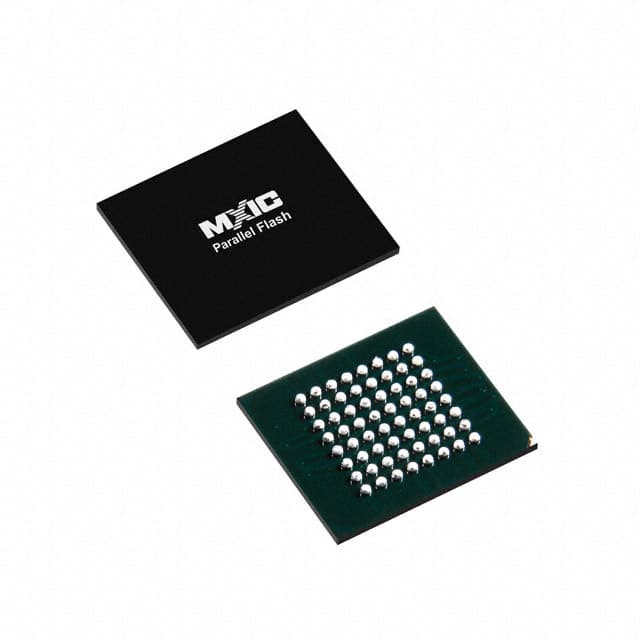Vedi le specifiche per i dettagli del prodotto.

MX29GL256FUXFI-11G
Introduction
The MX29GL256FUXFI-11G is a flash memory product that belongs to the category of non-volatile memory devices. This entry provides an overview of its basic information, specifications, pin configuration, functional features, advantages and disadvantages, working principles, application field plans, and alternative models.
Basic Information Overview
- Category: Non-volatile Memory Device
- Use: Storage of data in electronic devices
- Characteristics: High-speed read and write operations, low power consumption
- Package: 48-ball FBGA (Fine-pitch Ball Grid Array)
- Essence: Provides reliable and fast data storage for various electronic applications
- Packaging/Quantity: Typically supplied in reels or trays, quantity varies based on manufacturer's specifications
Specifications
- Capacity: 256 Megabits (32 Megabytes)
- Voltage Range: 2.7V - 3.6V
- Operating Temperature: -40°C to 85°C
- Interface: Parallel
- Speed: Up to 110ns random access time
- Endurance: 100,000 program/erase cycles per sector
Detailed Pin Configuration
The MX29GL256FUXFI-11G features a 48-ball FBGA package with specific pin assignments for power supply, address, data input/output, control signals, and other functions. Refer to the datasheet for the detailed pinout diagram.
Functional Features
- High-Speed Operations: Enables rapid data access and transfer
- Low Power Consumption: Ideal for battery-powered devices
- Reliable Data Storage: Ensures integrity and longevity of stored information
Advantages and Disadvantages
Advantages
- Fast read and write operations
- Low power consumption
- High endurance
- Compact FBGA package
Disadvantages
- Limited capacity compared to newer flash memory products
- Parallel interface may not be suitable for all applications
Working Principles
The MX29GL256FUXFI-11G utilizes NAND flash memory technology to store data. When data is written, it is stored in memory cells within the device. Reading data involves retrieving the stored information from the memory cells.
Detailed Application Field Plans
The MX29GL256FUXFI-11G is suitable for various applications including: - Embedded systems - Consumer electronics - Industrial equipment - Automotive electronics
Detailed and Complete Alternative Models
- MX29GL128FUXFI-11G: A lower capacity variant of the same series
- SST39VF3201B: Similar capacity and characteristics with different pin configuration
- W25Q256JV: Higher capacity alternative with similar features
In conclusion, the MX29GL256FUXFI-11G offers high-speed, reliable data storage in a compact package, making it suitable for a wide range of electronic applications.
Word count: 368
10 domande e risposte comuni relative all'applicazione di MX29GL256FUXFI-11G nelle soluzioni tecniche
What is the MX29GL256FUXFI-11G?
- The MX29GL256FUXFI-11G is a 256Mb flash memory device commonly used in embedded systems and other electronic applications.
What are the key features of the MX29GL256FUXFI-11G?
- The key features include a 3V voltage supply, fast access time, low power consumption, and a wide operating temperature range.
How is the MX29GL256FUXFI-11G typically used in technical solutions?
- It is often used for storing firmware, boot code, configuration data, and other non-volatile memory requirements in various electronic devices.
What are the interface options for the MX29GL256FUXFI-11G?
- The device supports common interfaces such as parallel NOR Flash interface and SPI (Serial Peripheral Interface).
What are the typical operating conditions for the MX29GL256FUXFI-11G?
- The device operates within a specified voltage range and temperature range, making it suitable for a variety of environments.
What are the programming and erasing methods for the MX29GL256FUXFI-11G?
- The device supports both byte/word programming and sector/chip erasing methods, providing flexibility for different application requirements.
Are there any special considerations for integrating the MX29GL256FUXFI-11G into a design?
- Designers should consider proper decoupling, signal integrity, and layout guidelines to ensure reliable operation and performance.
What are the typical power consumption characteristics of the MX29GL256FUXFI-11G?
- The device has low power consumption, making it suitable for battery-powered or energy-efficient devices.
What are the potential challenges when using the MX29GL256FUXFI-11G in a design?
- Challenges may include managing wear leveling, implementing error correction codes, and optimizing access times for specific applications.
Are there any recommended best practices for maximizing the performance and longevity of the MX29GL256FUXFI-11G?
- Best practices include following manufacturer guidelines, performing regular maintenance routines, and ensuring proper handling and storage conditions.
Is there anything else you would like to know about the MX29GL256FUXFI-11G or its application in technical solutions?

